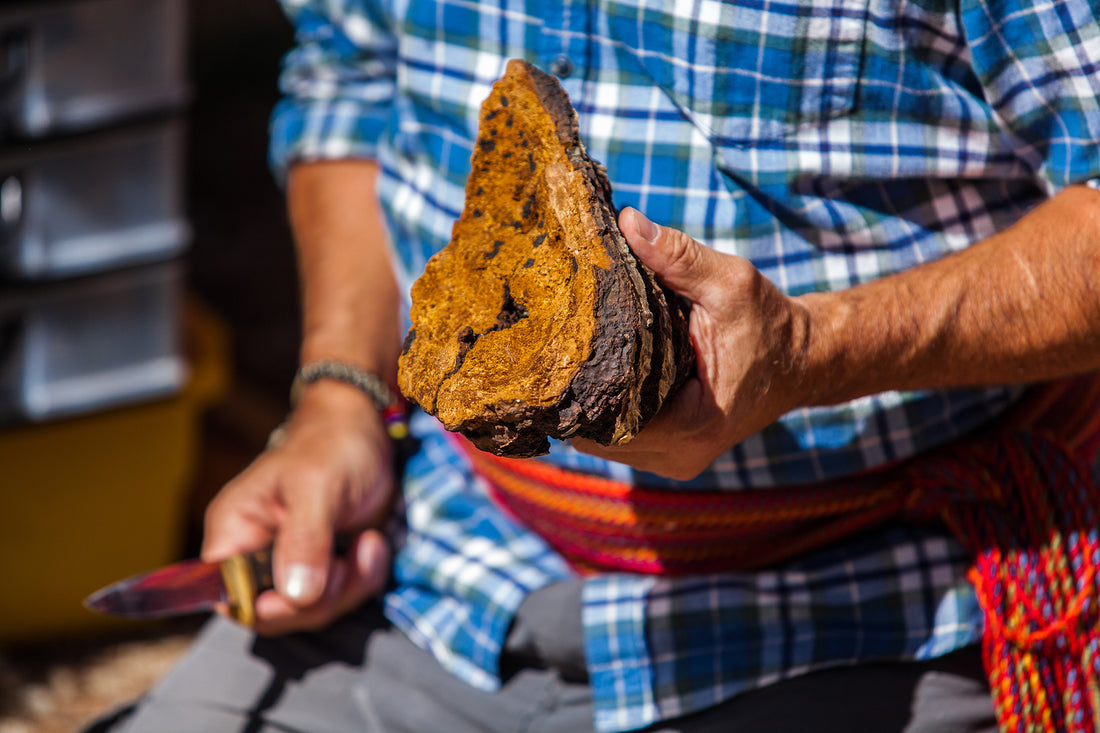Chaga, a type of medicinal fungus that grows on birch trees, has been used for centuries by indigenous people around the world. In North America, chaga has been used by First Nations communities for its potential health benefits and as a traditional remedy for various ailments.
Chaga has a long and rich history among First Nations communities. It was traditionally harvested in the fall and winter months, when the fungus is most abundant on birch trees. The harvesting process involved carefully removing the Chaga from the tree without damaging the tree itself, and then processing the fungus into a tea or tincture.[1]
Chaga was believed to have a range of health benefits, and was used to treat a variety of ailments, including stomach issues, respiratory problems, and skin conditions. It was also used as a tonic to boost the immune system and promote overall health and wellness.[2]
In addition to its medicinal properties, Chaga also held cultural and spiritual significance for many First Nations communities. It was believed to have the power to connect people with the natural world and the spirit realm, and was often used in shamanic practices and ceremonies.[3]
Today, Chaga continues to be used by First Nations communities for its potential health benefits. It is often used as a dietary supplement or brewed into a tea, and is believed to have antioxidant, anti-inflammatory, and immune-boosting properties.[4] Some studies have also suggested that Chaga may have anti-cancer properties, although more research is needed to confirm these findings.[5]
Despite the potential health benefits of Chaga, there are concerns about the sustainability of Chaga harvesting. In some areas, Chaga is overharvested, which can lead to long-term damage to the birch trees on which it grows.[6] To address this issue, some First Nations communities have implemented sustainable harvesting practices, such as selective harvesting and rotation of harvesting areas.[7]
In addition to concerns about sustainability, there are also issues surrounding the commercialization of chaga. Some companies have started marketing chaga products, such as supplements and teas, and are making claims about its health benefits that are not backed up by scientific evidence.[8] This has led to concerns about the safety and efficacy of these products, and the potential exploitation of First Nations communities who have been using Chaga for centuries.
Overall, Chaga holds an important place in the history and culture of First Nations communities. Its potential health benefits, cultural significance, and spiritual connections make it a valuable part of traditional medicine and a reminder of the deep connections between people and the natural world. It is important to use Chaga responsibly and sustainably, and to ensure that it is not exploited for commercial gain at the expense of First Nations communities. Better yet, learning about sustainable Chaga harvesting is an opportunity to learn about the many forest management practices Indigenous communities have been practicing for thousands of years.[9]
References
- Rogers, L. (2011). Healing with medicinal plants of the west - cultural and scientific basis for their use. University of New Mexico Press.
- Pasko, P., Kubica, P., Klimek, K., Ryszka, F., & Zagrodzki, P. (2012). Chaga mushroom extract inhibits oxidative DNA damage in lymphocytes of patients with inflammatory bowel disease. Scandinavian Journal of Gastroenterology, 47(6), 791–796. https://doi.org/10.3109/00365521.2012.668270
- Naranjo, E. (2015). Chaga: A Powerful Medicinal Mushroom with Deep Cultural Roots. Huffington Post. https://www.huffpost.com/entry/chaga-mushroom_b_8213336
- Shikov, A. N., Pozharitskaya, O. N., Krishtopina, A. S., Makarov, V. G., & Galambosi, B. (2016). Medicinal Plants of the Russian Pharmacopoeia; their history and applications. Journal of Ethnopharmacology, 194, 151– 161. https://doi.org/10.1016/j.jep.2016.08.020
-
Glamočlija, J., Ćirić, A., Nikolić, M., Fernandes, Â., Barros, L., & Calhelha, R. C. (2015). Chemical composition, antioxidant and antibacterial properties of Ganoderma lucidum and Trametes versicolor medicinal mushrooms and their application in the development of novel dairy products. International Journal of Food Science & Technology, 50(1), 61-70. https://doi.org/10.1111/ijfs.12603
-
Lee, Y. L., & Owens, J. N. (1997). Wild harvesting impacts and issues in the northwestern North American forest ecosystem. Journal of Sustainable Forestry, 4(1-2), 39-65. https://doi.org/10.1300/J091v04n01_04
-
Pilz, D., Molina, R., & Smulders, M. J. M. (2013). Commercial harvests of edible mushrooms from the forests of the Pacific Northwest United States: Issues, management, and monitoring for sustainability. Forest Ecology and Management, 291, 377-386. https://doi.org/10.1016/j.foreco.2012.11.013
-
Schultz, H. J. (2013). The Mushroom Hunters: On the Trail of an Underground America. Broadway Books.
- Joseph, L. (2023). Held by the Land: Stories of the Dzawada̱ʼenux̱w First Nation. Wellfleet Press, 28-33.

